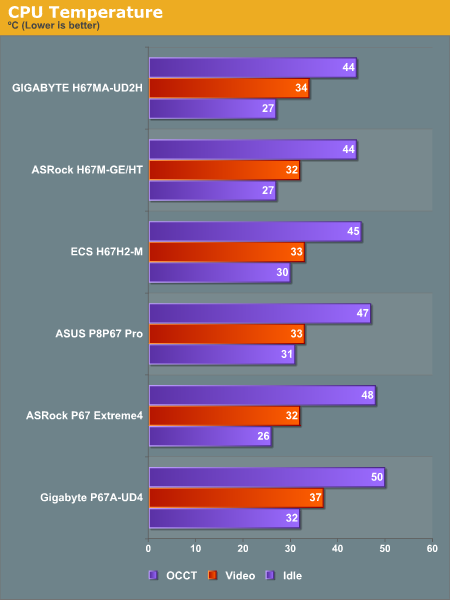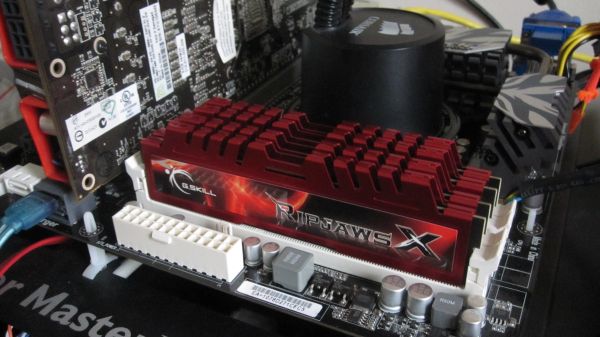H67 – A Triumvirate of Tantalizing Technology
by Ian Cutress on March 27, 2011 6:25 PM EST- Posted in
- Motherboards
- Sandy Bridge
- H67
Test Setup
| Processor |
Intel i5-2500K ES – 3.3 GHz (3.7 GHz Turbo) 4 Cores, 4 Threads, 6MB L3 |
| Motherboards |
ASRock H67M-GE/HT Gigabyte H67MA-UD2H ECS H67H2-M |
| Cooling | Corsair H50-1 Water Cooler |
| Power Supply | Enermax Modu87+ 600W 80PLUS |
| Memory |
Patriot Viper Extreme DDR3-2000 9-10-9-27 2x4GB Kit, 1.65V Corsair Vengeance DDR3-1600 9-9-9-24 2x4GB Kit, 1.50V G.Skill RipjawsX DDR3-2133 9-11-9-28 4x4GB Kit, 1.65V |
| Memory Settings | DDR3-1333 9-9-9-24 1T 2x4GB |
| Video Cards | XFX HD 5850 1GB |
| Video Drivers | Catalyst 10.12 |
| Hard Drive | Micron RealSSD C300 256GB |
| Optical Drives | LG GH22NS50 |
| Case | Open Test Bed – CoolerMaster Lab V1.0 |
| Operating System | Windows 7 64-bit |
| SATA Testing | Micron RealSSD C300 256GB |
| USB 2/3 Testing | Patriot 64GB SuperSonic USB 3.0 |
Many thanks to G.Skill for providing a set of their new RipjawsX for our test beds. This kit is their F3-17000CL9Q-16GBXLD, or in normal terms, a 16 GB (4x4 GB) kit, running at DDR3-2133 MHz with 9-11-9-28 timings at 1.65V. These are currently retailing at $370, and come with a Turbulence II RAM Cooler and a lifetime limited warranty.
Also many thanks to Crucial / Micron Technology for the 256GB C300 RealSSD for our motherboard test bed for SATA 3Gb/s and 6Gb/s testing. At AnandTech we’ve mentioned the C300 on many many numerous occasions, and our performance results can be seen in Bench. This particular model can be found online for $470.
Power Consumption

The H67 boards not running a discrete GPU draw more power under intense CPU load rather than GPU load, which is contrasting to any discrete GPU setup. The Gigabyte H67 board is easily uses the least power in this test.
CPU Temperatures

The H67 motherboards also run cooler than the P67. The ECS H67 runs a couple of degrees warmer than the other two - don't forget, the ECS has very large VRM coolers in comparison.











56 Comments
View All Comments
james.jwb - Sunday, March 27, 2011 - link
"However, I remember the time when I was a scrimping student. I wanted high gaming performance at the lowest cost – if Sandy Bridge was out then, and I was specifically after the Sandy Bridge platform over anything AMD, then a H67 with an i3-2100 and the biggest graphics card I could afford would be a viable option."When I was in this position, i'd go for the cheapest CPU and overclock it so it was faster than anything on the market. I'd be surprised if this wasn't the norm for people on a tight budget.
IanCutress - Sunday, March 27, 2011 - link
My argument mainly for my comment is that the CPU is becoming less of a factor for gaming, thus shifting the focus away from a CPU OC to a large GPU. It used to be the case that the CPU made a large difference as well, but it my mind it's not that much of an issue with a strong default CPU speed and cores available. Nevertheless, the AMD + cheap tri/quad core is on the other side of the coin.Ian
slickr - Monday, March 28, 2011 - link
Intel mobos are crap. Only for overclocking and only for graphics, where is the middle?And they are too expensive, hopefully AMD wipes the floor with them with their new Buldozer platform.
Jeffs0418 - Sunday, May 22, 2016 - link
Here we are 5 years later and...Y'know I was ready to move on from my Athlon 64 x2 5000+/AM2 platform(which I liked but was marginal for modern gaming). I was stoked for a nice capable FX4100/Bulldozer platform. But after reading disappointing reviews I ended up with a Core i3 2120/Sandy Bridge and a H61 mobo. Currently running a Core i5 2500(non-k) massaged a bit to 3.9GHz on all cores with aftermarket cooling on P67 mobo. Never have used Intel integrated graphics so I couldn't care less about that. But I am glad I didn't go with Bulldozer and am comfortable enough with my current setup even now that I'm in no hurry to upgrade.omelet - Sunday, March 27, 2011 - link
Wouldn't someone wanting SB gaming on a budget be more likely to want an H61? You can get such a board from ASRock for like 60 bucks. That's $60 more you'd be able to spend on the GPU, and you'd still have every feature you need. The only real performance difference is that there's no SATA 6Gbps, but budget gamers don't have drives that need that anyway.yzkbug - Sunday, March 27, 2011 - link
Totally agree. I’m looking for a good, reliable, budget-priced motherboard for my new HTPC. Would love to see a comparison review of H61 motherboards, especially the power comparison numbers.Taft12 - Sunday, March 27, 2011 - link
I'd need to know at what point the 6 PCIE lanes on H61 begins to get in the way of the GPUs performance. Someone will surely do the testing to show us in the near future. Noticeable on, say, a 6850? Or do we need a much higher-end GPU for a bottlenect?DanNeely - Sunday, March 27, 2011 - link
The GPU would still be running on the 16 lanes from the CPU. You just have 2 less lanes for 2ndary slots and onboard devices. I don't think it's likely to be an issue except in that you're much less likely to get a second x4 slot (1/11 vs 6/16 on newegg), and the 1 H61 board that does it has legacy PCI slots for the other 2 spaces, while 5/6 H67 boards have at least 1 1x slot as well.omelet - Sunday, March 27, 2011 - link
This is very confusing. All the boards claim to have x16 slots, but they can't possibly run at x16 if none of the boards on the table even have 16 lanes. A P67 running two cards would have to run each at 4x, or even lower if there are any x1 slots on the board (as there are on most boards).It might be explained as being an x16 slot running at a lower speed, except for the fact that P67 and P55 both specify that they can run two cards at x8/x8, which can only mean that they run the x16 slots at 8 lanes each when you have two cards plugged in. That should also be impossible according to the table.
Other sources I've found on the internet seem to imply that the x16 slot on the H61 runs at full x16 speed. I think perhaps we just need some clarification on what the values on the table here mean.
ajp_anton - Sunday, March 27, 2011 - link
There are two sources for PCIe lanes. The CPUs all have x16 (only for graphics), the rest (what is shown in the table) come from the motherboard chip (H67 etc).